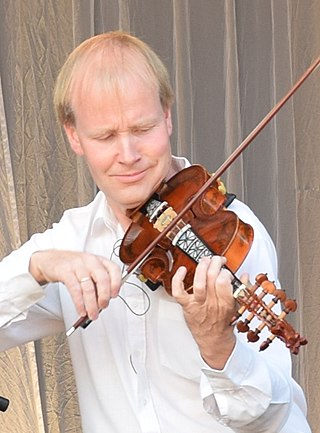
Baldr is a god in Germanic mythology. In Norse mythology, he is a son of the god Odin and the goddess Frigg, and has numerous brothers, such as Thor and Váli. In wider Germanic mythology, the god was known in Old English as Bældæġ, and in Old High German as Balder, all ultimately stemming from the Proto-Germanic theonym *Balðraz.

Höðr is a god in Norse mythology. The blind son of Odin, he is tricked and guided by Loki into shooting a mistletoe arrow which was to slay the otherwise invulnerable Baldr.

In Norse mythology, Sleipnir is an eight-legged horse ridden by Odin. Sleipnir is attested in the Poetic Edda, compiled in the 13th century from earlier traditional sources, and the Prose Edda, written in the 13th century by Snorri Sturluson. In both sources, Sleipnir is Odin's steed, is the child of Loki and Svaðilfari, is described as the best of all horses, and is sometimes ridden to the location of Hel. The Prose Edda contains extended information regarding the circumstances of Sleipnir's birth, and details that he is grey in color.

Hel is an afterlife location in Norse mythology and paganism. It is ruled over by a being of the same name, Hel. In late Icelandic sources, varying descriptions of Hel are given and various figures are described as being buried with items that will facilitate their journey to Hel after their death. In the Poetic Edda, Brynhildr's trip to Hel after her death is described and Odin, while alive, also visits Hel upon his horse Sleipnir. In the Prose Edda, Baldr goes to Hel on his death and subsequently Hermóðr uses Sleipnir to attempt to retrieve him.

Geirr Tveitt was a Norwegian composer and pianist. Tveitt was a central figure of the national movement in Norwegian cultural life during the 1930s.

Baldrs draumar or Vegtamskviða is an Eddic poem which appears in the manuscript AM 748 I 4to. It describes the myth of Baldr's death consistently with Gylfaginning. Bellows suggest that the poem was composed in the mid 10th century as well as the possibility that the author also composed Völuspá or at least drew from it, pointing at the similarity of stanza 11 in Baldrs draumar and stanzas 32-33 in Völuspá. Additionally, the 14th stanza of Þrymskviða is almost identical to Baldrs draumar's 1st stanza. Only in the last sentence do the two diverge from one another. Guðni argued that Þrymskviða was the younger poem of the two and it had received the stanza from Baldrs draumar.
Håvard Gimse is a Norwegian classical pianist from Kongsvinger, and the brother of the cellist Øyvind Gimse. He has received the Griegprisen (1996) and the Steinway Award (1995). Gimse has done several recordings for Naim Audio, Naxos Records, Sony Classical Records, Chandos Records and Simax.

Arve Moen Bergset is a Norwegian traditional folk singer, hardanger fiddler, and classical violinist. He is known both for his solo works as well as for his works with Bukkene Bruse.

Nykken is a symphonic poem composed by the Norwegian composer Geirr Tveitt in 1957.
Henrik Hellstenius is a Norwegian composer and musicologist.
Eldbjørg Hemsing is a Norwegian violinist. She started her career at the age of eleven. She premiered several works by Tan Dun in her solo debut with the Bergen Philharmonic Orchestra. She is the younger sister of the Norwegian violinist Ragnhild Hemsing and currently lives in Berlin.

The Stavanger Symphony Orchestra is a symphony orchestra based in Stavanger, Norway. The SSO principal venue is the Stavanger Concert Hall, performing in the Fartein Valen concert hall.
Edvard Sylou-Creutz was a Norwegian classical pianist, composer and radio personality, who was especially active in Nazi-controlled radio in Germany and occupied Norway between March 1940 and the autumn of 1942.

Geir Botnen is a Norwegian pianist. He focuses mainly on the works of Geirr Tveitt, but his repertoire also includes works by other composers.

Ragnhild Hemsing is a Norwegian classical violinist and the older sister of classical violinist, Eldbjørg Hemsing.
Baldr, Baldur or Balder is a Norse god.
Jan Erik Mikalsen is a Norwegian composer of contemporary music, living in Oslo.

Modern pagan music or neopagan music is music created for or influenced by modern Paganism. Music produced in the interwar period include efforts from the Latvian Dievturība movement and the Norwegian composer Geirr Tveitt. The counterculture of the 1960s established British folk revival and world music as influences for American neopagan music. Second-wave feminism created women's music which includes influences from feminist versions of neopaganism. The United States also produced Moondog, a Norse neopagan street musician and composer. The postwar neopagan organisations Ásatrúarfélagið in Iceland and Romuva in Lithuania have been led by musicians.
A Hundred Hardanger Tunes is a collection of folk songs from the Hardanger region of Norway arranged for orchestra by the composer Geirr Tveitt between 1954 and 1963. Of the originally planned 100 tunes, 4 suites with a total of 60 songs are extant.











